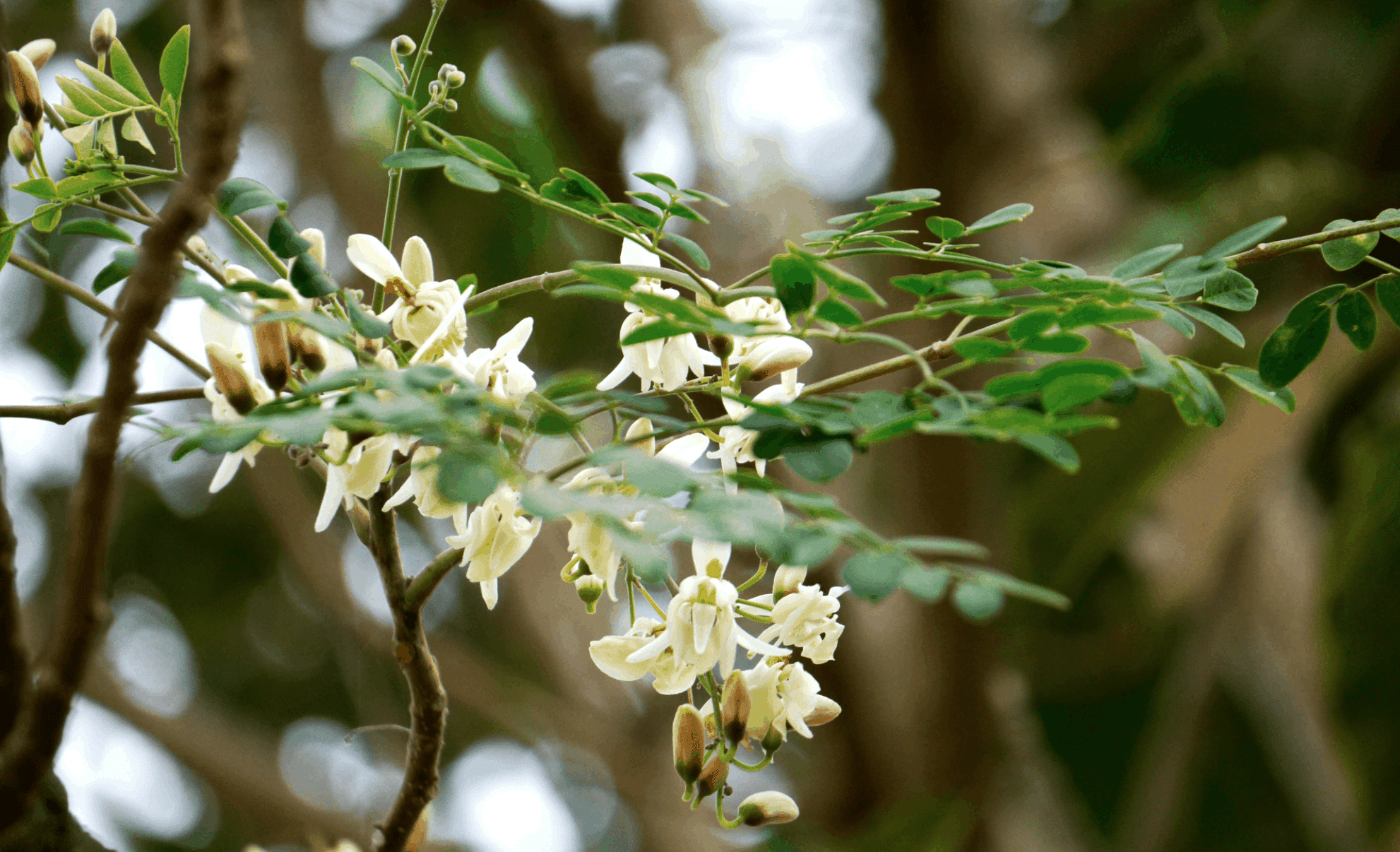If you’ve done a few quick Google searches about Moringa, you might have seen conflicting information about how much of it is edible.
There are some articles that claim that every part of the Moringa tree, from its leaves to its roots, is safe to eat.
There are others that insist you should only eat the leaves or drumsticks, and avoid everything else. When we first started researching Moringa years ago, we ran into this exact same situation.
So we did an awful lot of research, all for the purposes of answering this single question below.
Can you eat every part of the Moringa Tree?
Historically, humans have eaten every part of the Moringa tree, either for food or as medicine. However, while some parts of the tree are absolutely safe for consumption (leaves, drumsticks, seed oil), other parts of the tree should only be consumed in very limited quantities and/or only after careful preparation (roots, bark, flowers).
That’s the basic overview. Let’s take a step-by-step look at every part of the Moringa tree and discuss what you should or shouldn’t eat.

Moringa Leaves and Drumsticks: A Nutritious Addition to Any Meal
Scientists and researchers have been studying Moringa leaves for decades. Humans have been eating both the leaves and drumsticks for thousands of years.
Every piece of research and experiential evidence we have says that both Moringa leaves and drumsticks are entirely safe in commonly-used servings.
Moringa leaves can be used fresh, dried, or in powders. They can be taken in teas, cooked into recipes, or added as a garnish atop any dish. You can eat Moringa leaves directly from the branch, or you can crush and powder them to add to meals for the rest of the year.
We recommend sticking to 5-10 grams of Moringa powder or 5-15 grams of Moringa leaves daily, but all in all, Moringa leaves are entirely safe to consume.
The same is true of drumsticks. Moringa drumsticks are a bit less commonly eaten, but you can absolutely add them to most meals.
They can be sliced, diced, and added to soups and curries. You can eat them fresh, cooked, or pickled. We recommend an individual serving size of 1-2 drumsticks daily.
Regardless of how you choose to add leaves or drumsticks to your diet, both are safe, nutritious, and wildly beneficial. Is the same true of the rest of the tree, however?
Moringa Flowers Edible
Moringa flowers are often likened to mushrooms in terms of taste, with a comparable spongy texture and a familiar aftertaste. However, expecting an exact mushroom flavor might lead to surprise, as they have distinct characteristics.
While Moringa leaves boast a slightly higher nutritional content, the flowers are no slouch either. Packed with essential vitamins, minerals, protein, carbohydrates, and even more dietary fiber than Moringa leaves, they also share the anti-inflammatory properties found in the leaves.
Moringa flowers offer versatility in culinary applications. They can be boiled to make a medicinal tea, known for its anti-inflammatory benefits and use in addressing UTIs. Alternatively, frying them in oil makes for a flavorful addition to salads. In Ayurvedic practices, they are employed to support breastfeeding mothers and enhance milk supply.
However, there are important considerations. Moringa flowers possess contraceptive properties, potentially inducing uterine contractions in large quantities, leading to a risk of miscarriage during pregnancy. The exact quantities that pose a risk are unclear, making it advisable for pregnant or conception-seeking individuals to avoid Moringa flowers.
Additionally, it is crucial to cook Moringa flowers before consumption. Whether frying them in oil or boiling in water, avoiding raw consumption is recommended.
A third consideration is portion size. Moringa flowers are potent laxatives, so it’s wise to start with a small portion to avoid potential stomach cramps and excessive trips to the restroom.
Additional reading can be found here, at Morning Garden’s signature Moringa 101 post:
Moringa Seed Oil: A Healthy Alternative to Vegetable Oil
Moringa seed oil, an unexpected gem that we didn’t know existed for years, has become a staple in our household. Derived from the seeds, this versatile oil goes beyond culinary use, finding its place in hair masks, moisturizers, and DIY perfumes.
While Moringa oil is an excellent alternative to vegetable, canola, or olive oil in cooking, it offers a slightly sweeter taste without overpowering the flavor of savory dishes. Rich in antioxidants and nutrients found in Moringa seeds, it enhances the nutritional profile of your culinary creations.
What’s more, making Moringa oil at home is a feasible task, even without an oil press. For those interested in the DIY approach, check out our article on making Moringa oil.
While we wouldn’t suggest chugging Moringa oil like water, incorporating it into your cooking is entirely safe. In summary, Moringa seed oil is a delectable part of the Moringa tree that you can confidently include in your diet.
Moringa Seeds: Edible, But Use in Moderation!
Immature Moringa seeds are indeed edible, but it’s recommended to consume them in moderation, treating them like pills—perhaps one or two a day.
There are various ways to enjoy eating Moringa seeds:
- Fry them in a bit of oil, and they’ll puff up like popcorn kernels. Add them to salads, soups, or meat and vegetable dishes.
- Boil them for a solo snack or incorporate them into your meals.
- Use them to make Moringa oil.
Initially tasting vaguely sweet, Moringa seeds leave a bitter aftertaste. The taste becomes easier to get used to over time, but resist the temptation to consume them like nuts or sunflower seeds. While they offer ample vitamins, minerals, fiber, and antioxidants, be cautious—they also act as a potent laxative.
Consuming Moringa seeds in moderation is key. Start with a small portion, such as a single seed or half, especially if you have a sensitive stomach. Gradually increase your intake as you feel comfortable, but avoid eating them by the handful to prevent stomach cramps and frequent restroom visits.
While various parts of the Moringa tree can be safely consumed in moderation, there are two parts that are not recommended for consumption.
Moringa Root: Can you Eat Moringa Stems?
Moringa roots have a long history of medicinal use, known for treating ulcers, inflammation, and as a cardiac stimulant. They possess anti-fungal, anti-inflammatory, and anti-bacterial properties, acting as diuretics and having pain-killing properties. Despite their nutritional content with vitamins, alkaloids, and minerals like calcium, magnesium, and sodium, Moringa roots contain toxic chemicals and alkaloids, including morphine, which can be harmful in large quantities.
Some adverse effects of consuming Moringa roots include nausea, dizziness, nerve paralysis, and the potential to induce uterine contractions, making them historically used as a contraceptive and capable of causing miscarriage in pregnant women. However, the lack of sufficient research as of April 2019 prevents a clear determination of safe consumption levels.
Due to the potential risks, it is not recommended to consume Moringa roots. There are other parts of the Moringa tree that are safe for consumption, and it’s advisable to avoid the roots until more conclusive research becomes available.
Moringa Bark: Can you Eat The Moringa Trunk?
Moringa bark, particularly root bark, has a historical use in traditional medicine for treating inflammation, urinary tract infections (UTIs), and ulcers. Research, including a study on UTI treatment, suggests the effectiveness of Moringa bark, surpassing modern medical treatments in certain cases. The study utilized a specific decoction, indicating safety for at least three weeks with no reported adverse effects.
However, Moringa bark is toxic in larger quantities, containing alkaloids that can lead to adverse effects ranging from nausea to paralysis and even death. Similar to Moringa roots and flowers, the bark can induce uterine contractions, posing a risk of miscarriage in pregnant women. Insufficient research on Moringa bark prevents a definitive understanding of safe quantities, considering various factors.
Due to the lack of conclusive research, it is strongly recommended to avoid Moringa bark entirely to mitigate potential risks.
Conclusion
Moringa is a highly nutritious and healthy food product, with its leaves, drumsticks, and seeds being beneficial additions to meals. However, caution is advised with Moringa flowers during pregnancy due to potential dangers.

For years now, Moringa has been a daily consumption in my life, incorporated in various forms such as capsules, food recipes, and soothing teas. Initially, my daughter and I embarked on this journey as an experiment, but as time went on, I delved deeper into its remarkable potential and unearthed the unlimited benefits it offers for our well-being and health. I got motivated by how much it positively impacted me and decided to share my insights about Moringa’s profound impact on health and overall living through my blog posts.

I like reading through an article that will make people think. Also, thank you for permitting me to comment!